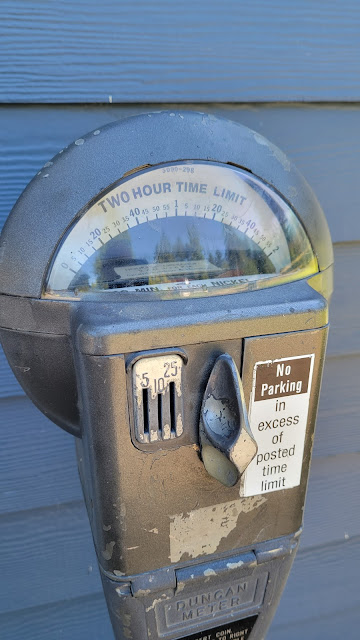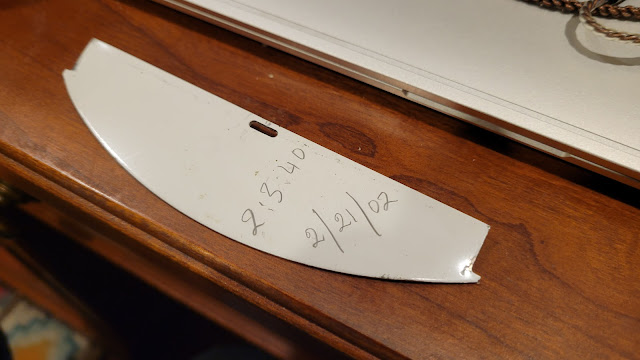I picked up this gem a couple of months ago while on a small anniversary celebration trip to Fairhaven, near Bellingham. We were walking around town and came across a small hole in the wall eclectic store that had quite the assortment of "stuff". Amongst the stuff was this parking meter. I've always been intrigued by them, so the $35 asking price sounded very reasonable. Home it came.
I had no idea if the thing even worked, but I took a chance that since these were built to take abuse, the odds of it being broken were small.
I'd never seen the internal workings of a parking meter. They are both simple and complex. The clockworks is very basic. It is something you'd find in an old Westclox-type Big Ben alarm clock - no jewels, with all-brass gears and plates. Something unusual was that the tick (beat rate) was a very-slow once per second. Typical cheap clock beat rates are four or five times per second.
If a person puts in a coin and doesn't wind the knob fully, the knob will stay at that position and not return to its rest position. When this is done, the "VIOLATION" flag will show, indicating it is a violation to not wind the knob fully. In the old days (prior to the VIOLATION flag), some nefarious folks would partially wind the knob and then let it sit at that position until the meter checker came around, who then would fully wind the knob and start the meter ticking. This would give the person that much extra time before the meter timed out.
While the clock is simple, the winding mechanism is a little more complicated. A coin falls into a ramped area, and when the outer knob is turned, the coin catches some part of the spring winder. If you notice the sequence of slots for putting money in (top photo), the nickel slot is furthest from the center winding shaft and the quarter slot is closest to the shaft. If you drop in a quarter, the winding of the clock spring begins early in the twisting of the knob, while the winding for the dime begins later, then the nickel location begins winding the spring the latest.
It appears that some parking meter technician tested this meter for accuracy twenty years ago. It ran three minutes and forty seconds slow in two hours, or 2.5% slow. Not bad for a lowly parking meter.
While on that same anniversary trip, we drove by a "free" sign that had this cast iron umbrella base (below) next to it. I pulled a U-eee just down the road and went back to pick it up. Boy was it heavy. Must weigh 40 pounds.
And then yesterday I picked up a piece of 2-inch exhaust pipe to make a stand for the parking meter. First order of business was to make a long bolt. I started with a piece of 3/8-inch rebar and welded the appropriate pieces (bolt head and threaded end) to each end of the rebar.
The exhaust pipe was a bit small so I used a large 3/4-inch socket and sledge hammer to flare out the ends to fit the base of the meter and the umbrella base.














No comments:
Post a Comment